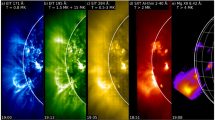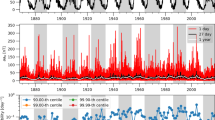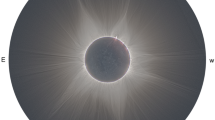Abstract
The relationship between two classes of coronal holes and high-speed quasi-stationary streams of solar wind at the Earth’s orbit is investigated. “Open” coronal holes, whose area is invariable or increases with the height over the solar surface, are rated in the first class, and “closed” coronal holes with areas decreasing with the height are referred to as second-class holes. The parameters of the coronal holes are determined from IR and EUV images and spectroheliograms. It is shown that most open coronal holes can be associated with high-speed solar-wind streams, while most closed coronal holes exhibit a much lower correlation with such streams.
Similar content being viewed by others
References
Beigman, I.L., Bozhenkov, S.A., Zhitnik, I.A., et al., Extreme Vacuum Ultraviolet Solar Spectra Obtained during the SPIRIT Experiment aboard CORONAS-F: A Catalog of Lines in the Range 280–330 [A], Pis’ma Astron. Zh., 2005a, vol. 31, no. 1, pp. 39–58 [Astron. Lett. (Engl. Transl.), vol. 31, no. 1, pp. 37–56].
Bohlin, J.D. and Sheeley, N.R., Jr., Extreme Ultraviolet Observations of Coronal Holes, Sol. Phys., 1978, vol. 56, pp. 125–151.
Bugaenko, O.I., Grechnev, V.V., Zhigalkin, R.K., et al., Investigations of Solar Formations Using Complex Observations from the Earth and onboard the CORONAS-F Satellite: I. Methods of Observations and Analysis of Solar Images Registered in Different Spectral Ranges, Izv. Krym. Astrofiz. Obs., 2004a, vol. 100, pp. 102–114.
Bugaenko, O.I., Zhitnik, I.A., Ignat’ev, A.P., et al., Investigations of Solar Formations Using Complex Observations from the Earth and onboard the CORONAS-F Satellite: II. Magnetic Fields in Coronal Holes at Different Altitudes, Izv. Krym. Astrofiz. Obs., 2004b, vol. 100, pp. 115–127.
Bugaenko, O.I., Zhitnik, I.A., Ignat’ev, A.P., et al., Investigations of Solar Formations Using Complex Observations from the Earth and onboard the CORONAS-F Satellite: III. Boundaries of Coronal Holes and their Relation to Active Formations, Izv. Krym. Astrofiz. Obs., 2004c, vol. 100, pp. 128–143.
Eselevich, V.G., Kaigorodov, A.P., and Fainshtein, V.G., Some Peculiarities of Solar Plasma Flows from Coronal Holes, Planet. Space Sci., 1990, vol. 38, p. 459–469.
Fainshtein, V.G., Eselvich, V.G., and Rudenko, G.V., Methods of Space Weather Prediction from Characteristics of Solar Magnetic Fields, Soln.-Zemn. Fiz., 2004, vol. 4, pp. 33–39.
Hudson, H.S., Coronal Holes as Seen in Soft X-Rays by Yohkoh, Proc. SOHO 11 Symp. “From Solar Min to Max: Half a Solar Cycle with SOHO”, Davos, Switzerland, 2002, ESA SP-508, pp. 341–349.
Kahler, S.W., Davis, J.M., and Harvey, J.W., Comparison of Coronal Holes Observed in Soft X-Ray and HE I 10830 A Spectroheliograms, Sol. Phys., 1983, vol. 87, pp. 47–56.
Khabarova, O.V., Kuzin, S.V., Bogachev, S.A., et al., Solar Flux Variations at 175 and 304 [A] and their Relation to Solar Wind Parameters, Astron. Vestn., 2006, vol. 40, no. 4, pp. 372–378 [Sol. Syst. Res. (Engl. Transl.), vol. 40, no. 4, pp. 341–347].
Levine, R.H., Open Magnetic Fields and the Solar Cycle. I. Photospheric Sources of Open Magnetic Flux, Sol. Phys., 1982, vol. 79, pp. 203–230.
McIntosh, P.S., Inference of Solar Magnetic Polarities from H-alpha Observations, Solar Activity Observations and Predictions (Progress in Astronautics & Aeronautics), McIntosh, P.S., and M. Dryer, Eds., Cambridge: MIT Press, 1972, pp.65–92.
Malanushenko, E.V. and Stepanian, N.N., Areas of Coronal Holes at the Levels of Solar Chromosphere and Corona, Proc. IV Russ. Symp. “Mathematical Models of the Sun-Earth Environment”, Kropotkin, A.P., Antonova, A.E., and Veselovsky, I.S., Eds., Moscow: Moscow State Univ, 1996, pp. 41–47.
Nolte, J.T., Krieger A.S., Timothy A.F., et al., Coronal Holes as Sources of Solar Wind, Sol. Phys., 1976, vol. 46, p. 303–309.
Oraevskii, V.N. and Sobel’man, I.I., Comprehensive Studies of Solar Activity on the CORONAS-F Satellite, Pis’ma Astron. Zh., 2002, vol. 28, no. 6, pp. 457–467 [Astron. Lett. (Engl. Transl.), vol. 28, no. 6, pp. 401–410].
Pneuman, G.W., Hansen, S.F., Hansen, R.T., et al., On the Reality of Potential Magnetic Fields in the Solar Corona, Sol. Phys., 1978, vol. 59, pp. 313–330.
Rudenko, G.V., Extrapolation of the Solar Magnetic Field within the Potential-Field Approximation from Full-Disk Magnetograms, Sol. Phys., 2001, vol. 198, pp. 5–30.
Sheeley, N.R., Jr. and Harvey, J.W., Coronal Holes, Solar Wind Streams, and Geomagnetic Disturbances during 1978 and 1979, Sol. Phys., 1981, vol. 70, pp. 237–249.
Stepanian, N.N. and Malanushenko, E.V., Relation of Coronal Holes to Magnetic Fields, Izv. Krym. Astrofiz. Obs., 2001, vol. 97, pp. 76–80.
Stepanian, N.N. and Malashchuk, V.M., Evolution of Coronal Holes at Different Altitudes of the Solar Atmosphere, Izv. Krym. Astrofiz. Obs., 2002, vol. 98, pp. 8–16.
Stepanian, N.N., Dolgopolova, E.V., Dolgopolov, A.V., et al., Solar Universal Spectrometer, Izv. Krym. Astrofiz. Obs., 2000, vol. 96, pp. 194–204.
Suess, S.T., Richter, A.K., Winge, C.R., et al., Solar Polar Coronal Hole-A Mathematical Simulation, Astrophys. J., 1977, vol. 217, pp. 296–305.
Urnov, A.M., Shestov, S.V., Bogachev, S.A., et al., On the Spatial and Temporal Characteristics and Formation Mechanisms of Soft X-Ray Emission in the Solar Corona, Pis’ma Astron. Zh., 2007, vol. 33, no. 6, pp. 446–462 [Astron. Lett. vol. 33, no. 6, pp. 396–410].
Zhitnik, I.A., Bougaenko, O.I., Delaboudiniere, J.-P., et al., SPIRIT X-Ray Telescope/Spectroheliometer Results, ESA SP-506, 2002, vol. 2, pp. 915–918.
Zhitnik, I.A., Kuzin, S.V., Urnov, A.M., et al., Solar Spectra of Extreme VUF-Range Obtained during Experiment SPIRIT aboard CORONAS-F: II. A Catalog of Lines in the Range 176–207 [A], Pis’ma Astron. Zh., 2007 (in press).
Zirker, J., Ed., Coronal Holes and High-Speed Wind Streams, Boulder: Colorado Assoc. Univ. Press., 1977, pp. 257–263.
Author information
Authors and Affiliations
Additional information
Original Russian Text © N.N. Stepanian, S.V. Kuzin, V.G. Fainshtein, G.V. Rudenko, V.M. Malashchuk, V.A. Perebeinos, N. I. Shtertser, R.K. Zhigalkin, I.A. Zhitnik, A.A. Pertsov, 2008, published in Astronomicheskii Vestnik, 2008, Vol. 42, No. 1, pp. 86–92.
Rights and permissions
About this article
Cite this article
Stepanian, N.N., Kuzin, S.V., Fainshtein, V.G. et al. Relationship between the coronal holes and high-speed streams of solar wind. Sol Syst Res 42, 83–89 (2008). https://doi.org/10.1134/S0038094608010097
Received:
Published:
Issue Date:
DOI: https://doi.org/10.1134/S0038094608010097




